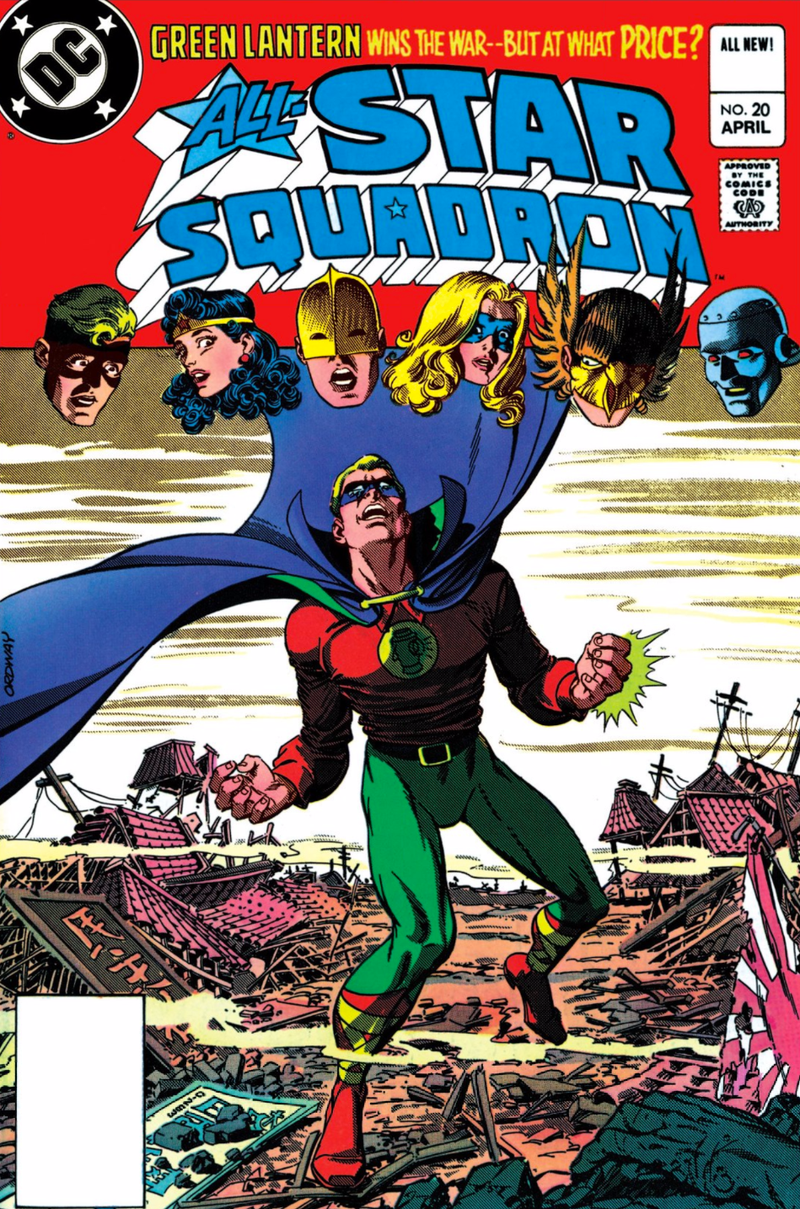
The first time I read All-Star Squadron #20, somewhere in my pre-teens, it blew me away. There it was, the answer to the question I didn’t even know I had: how come superheroes don’t just fix everything?
Reading All-Star Squadron was like getting an undergraduate degree in comics history. Written by Roy Thomas with art by Jerry Ordway for much of its six-year run, the series rounded up almost every WWII-era superhero DC Comics had the publishing rights to and threw them onto a giant super-team. It’s where I first learned about Earth-2 and the metatextual explanation that allowed older and newer versions of Superman, Batman and Wonder Woman to co-exist at the same time. All-Star Squadron #20 was maybe the first comic where I saw rose-tinted ideal of always-smiling superhero altruism get scuffed up a little.
Spoilers follow.

The basic set-up in All-Star Squadron #20 is a standard-issue premise: telepathic villain Brainwave has captured the Justice Society and trapped them in a shared mindscape where they’ve fought on the war’s front lines and lost. (This issue just became available digitally.) The members of DC’s first-ever superteam will all die if just one of them succumbs to the stress of the ordeal. The All-Star Squadron tracks down Brainwave and rushes into the hallucination to rescue the Justice Society, but they too fall prey to the imaginary Japanese enemies inside the simulation.
It’s ultimately up to Alan Scott, the original Green Lantern to fly in and save the day. His powers were like those of Hal Jordan, John Stewart and the other characters who would use the same name: powered by his will, a magic ring can create energy constructs of almost anything Scott can think of. Coming up on the shattered bodies of his fellow heroes in Brainwave’s faux-Japan, Green Lantern goes on a massive rampage.


The heavy-handed metaphor here equates a superhero’s power with that of an atom bomb. But, where this story grabbed me as a kid was the idea that Green Lantern is an atom bomb with a conscience. After reckoning with what he’s done, Alan Scott decides that no one man can wield all that power and is about to kill himself out of guilt.

The other members of the Justice League return to consciousness in time to stop Green Lantern from doing this and they all return to reality. Once there, Green Lantern utters the words “I am become Death, shatterer of worlds” from the Bhagavad Gita.


That moment is a reference to J. Robert Oppenheimer—the man often called the father of the atomic bomb—who said that the test detonation of the first atomic bomb made him recall that passage from the Hindu spiritual text.
Roy Thomas was a history buff and part of the first generation of comics fans who became professionals in the 1960s. He was amongst the second wave of creators at Marvel during the publisher’s rebirth as a superhero powerhouse, helping codify the melodramatic Silver Age plots and dialogue that would define decades of comics scripting. You can see some of his fannish obsession at work in All-Star Squadron. Set during the Second World War, All-Star Squadron saw Thomas building and refining a canonical timeline for DC’s Golden Age history. A big chunk of issue 20 is showing what Superman, Batman, Flash and other specific characters were doing during a given month in 1942. That cataloguing means almost nothing to the issue’s actual plot but is stitching together a shared universe out of the uncoordinated freshman efforts of superhero comics’ earliest creators. It’s world-building in a very raw form and Thomas’ insertion of postmodern sensibility is extremely powerful in this context. He’s slipping in the idea that the most beloved costumed characters of the Greatest Generation had human foibles that we never saw.
In 1983, the notion that longstanding comics tropes could be deconstructed and looked at from the inside out wasn’t a widespread idea yet. Having a hero deal with the psychological weight of wielding massive power was a relatively rare occurrence. All-Star Squadron #20 also serves as a meditation on the grisly toll that war takes on individual bodies and the collective, unspoken American shame after dropped atomic bombs on Hiroshima and Nagasaki, which makes it more noteworthy.
All-Star Squadron #20 probably has predecessors I’m not remembering here and later comics would scrape away the golden patina of always-right superheroes even more in service of more complex psychological portraits. But this single issue will always stand out for me as a bit of an cold-war awakening as to the terrible potential of what it meant to have superpower in the real and imagined world.